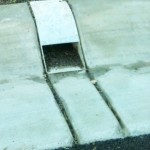Stormwater Discharge Point

One check that is often forgotten when buying a house block in an established suburb is how storm water is removed from the site.
Forty, or more, years ago when land was cheaper, it was not unusual for blocks to be quite large compared with the size of the house.
Disposing of storm water by allowing it to soak into the garden in the garden was acceptable. (This is still effective in sandy areas such as much of Western Australia)
As a result many properties were built without connection to a surface water sewer.
Modern Knock Down and Rebuild Problems
If you buy block in an older suburb with the intention of subdividing, or demolishing and building a bigger house, you could have problems if you haven’t got access to a storm water sewer.
Disposal to a much smaller garden area probably won’t work.
In order to protect adjoining properties from overflows from your property the council are likely to make discharge to an approved point conditional on any development approval.
Dealing with the attendant problems if you plan to extend or subdivide a block without a stormwater discharge point can add thousands of dollars to your costs.
Options
Possible options are:
- Soakwells. If you are lucky enough to have a sandy block soakwells may be a solution. Low cost.(see this link: Soakwells )
- Pipe to existing surface water sewer. This may involve negotiating with adjacent property owners. Very difficult to achieve unless the affected neighbours also want to subdivide. Very expensive.
- Discharge to Street
 Check with your council to see if this is permitted. A typical street connection will look something like this kerb outlet. Can be a reasonable cost if the block is above the road, or very expensive if the block is below road level Pumps and a detention tank will be needed (See these links Pumps and Detention Tank)
Check with your council to see if this is permitted. A typical street connection will look something like this kerb outlet. Can be a reasonable cost if the block is above the road, or very expensive if the block is below road level Pumps and a detention tank will be needed (See these links Pumps and Detention Tank)
See Guide to Buying a Block for more information